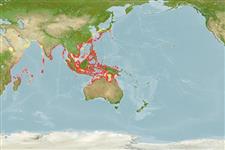Common names from other countries
>
Anguilliformes (Eels and morays) >
Ophichthidae (Snake eels) > Ophichthinae
Etymology: Brachysomophis: Greek, brachys, eia = short + Greek, soma = body + Greek, ophis = serpent (Ref. 45335); cirrocheilos: From apparently a combination of Latin ('cirrus' = tendril) and Greek ('cheilos' = lip)..
More on author: Bleeker.
Environment: milieu / climate zone / depth range / distribution range
экология
морской; солоноватоводный ассоциированный с рифами; пределы глубины 1 - 38 m (Ref. 42180). Tropical; 39°N - 20°S, 35°E - 148°E (Ref. 42180)
Indo-West Pacific: Red Sea and East Africa to Japan, Taiwan south to Indonesia and Australia.
Size / Вес / Возраст
Maturity: Lm ? range ? - ? cm
Max length : 159 cm TL самец/пол неопределен; (Ref. 42180)
позвонки: 135 - 140. Coloration pale, overlain dorsally and along flanks with irregular brown smudges. A moderately elongate species with tail 51-58% and head 11-14% of TL; dorsal fin arising well behind pectoral-fin tips; pectoral fins not elongate; snout moderate, about 3.2 in jaw; jaws elongate; lower jaw extending beyond snout; nostrils in very short tubes in upper lip and closely associated; labial fringe well-developed but cirri not elongate on jaws, with cauliflower-like projections at tips; center of eye behind anterior 40% of jaw; interorbital space and top of head flat, dorsal head profile nearly flat from mid-head to snout tip; head pores inconspicuous; free sensory neuromasts not visible on nape; teeth conical. Numerous prominent barbels on both lips; outer row of maxillary teeth not visible when are closed (Ref 42180).
Most commonly found in sand and mud, near coastal reefs at depths of 1 up to at least 10 m. Burrows into the sand tail-first until only its eyes and the top of its snout are visible. Sometimes seen with only its head or snout protruding from the sand. More commonly encountered at night but also seen with its head protruding out of the substrate during the day. Observed with cleaner shrimp Periclimenes magnificus on its head. The shrimp would swim off for short periods and then return to this species (Ref. 42180). Feeds on small fishes and crustaceans (Ref. 2334).
Life cycle and mating behavior
Maturities | размножение | Spawnings | Egg(s) | Fecundities | личинки
McCosker, J.E. and J.E. Randall, 2001. Revision of the snake-eel genus Brachysomophis (Anguilliformes: Ophichthidae), with description of two new species and comments on the species of Mystriophis. Indo-Pac. Fish. (33):1-32. (Ref. 42180)
Статус Красного Списка МСОП (Ref. 130435)
CITES (Ref. 128078)
Not Evaluated
Угроза для людей
Harmless
Использование человеком
дополнительная информация
инструменты
Специальные отчеты
Скачать в формате XML
ресурсы в Интернет
Estimates based on models
Preferred temperature (Ref.
115969): 25 - 29, mean 27.9 (based on 520 cells).
Phylogenetic diversity index (Ref.
82804): PD
50 = 0.5078 [Uniqueness, from 0.5 = low to 2.0 = high].
Bayesian length-weight: a=0.00089 (0.00039 - 0.00204), b=3.00 (2.80 - 3.20), in cm Total Length, based on LWR estimates for this (Sub)family-body shape (Ref.
93245).
Trophic level (Ref.
69278): 4.0 ±0.66 se; based on food items.
устойчивость к внешним воздействиям (Ref.
120179): низкий, минимальное время удвоения популяции 4.5-14 лет (Preliminary K or Fecundity.).
Fishing Vulnerability (Ref.
59153): Very high vulnerability (90 of 100).
